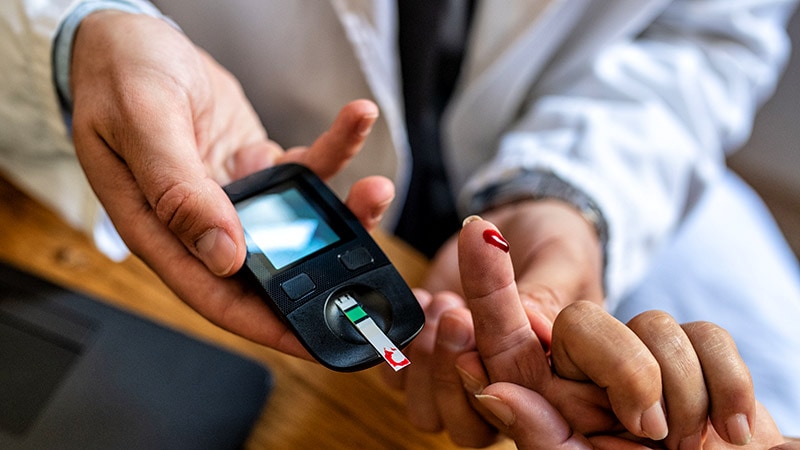Machine Learning Model Accurately Predicts Inpatient Hypoglycemic Events Using Capillary Blood Glucose Data
Core Concepts
A machine learning model can accurately predict the risk of inpatient hypoglycemic events using only capillary blood glucose data, with the most predictive features being extreme and variable glucose measurements.
Abstract
The content describes the development and validation of a machine learning model designed to predict inpatient hypoglycemic events using only capillary blood glucose (CBG) data. The model was trained on a large dataset of over 259,000 patients and nearly 5 million rows of CBG information from the National Health Service (NHS) in the Greater Glasgow and Clyde region.
The model was able to predict the probability of a hypoglycemic event (defined as CBG < 4 mmol/L) occurring between days 2 and 31 of a patient's admission. The model's accuracy, as measured by the area under the receiver operating characteristic curve, increased from around 0.78 at day 2 to 0.85 at day 7 and remained at around 0.85 out to day 31.
A separate analysis was conducted to determine the most predictive characteristics of the CBG data. It was found that on day 1 of admission, age was the most impactful feature, while by day 7, the most important factors were minimum CBG in the 48 hours prior, glycemic variability, and the trend in blood glucose over the preceding 24 hours.
The researchers plan to initially trial the model in diabetes wards and later in non-diabetes wards to assess its real-world application. They also intend to develop a just-in-time education intervention to be delivered alongside the hypoglycemia predictions to help clinical staff minimize the occurrence of these events.
AI Model Predicts Inpatient Hypoglycemic Events
Stats
"Inpatient hypoglycemic events are associated with patient morbidity and mortality."
"At any one time, around one quarter of the beds in his hospital were occupied by patients with diabetes."
Quotes
"We've shown the model has very good predictive power for hypoglycemic events. Now, we need to show that staff can act on these alerts efficiently and that this will translate into significant clinical impact."
"Inpatient hypos are not just an inconvenience, as previously thought, they are an outcome that we really need to prevent as a primary aim of therapy."
Key Insights Distilled From
by Becky Mccall at www.medscape.com 04-25-2024
https://www.medscape.com/viewarticle/ai-model-predicts-inpatient-hypoglycemic-events-2024a100081k
Deeper Inquiries
How can the model be further improved to increase its accuracy and reliability in predicting inpatient hypoglycemic events?
To enhance the model's accuracy and reliability in predicting inpatient hypoglycemic events, several strategies can be implemented. Firstly, incorporating additional relevant features such as patient demographics, comorbidities, and medication history could provide a more comprehensive understanding of the patient's condition and potential risk factors. Furthermore, refining the machine learning algorithms by fine-tuning hyperparameters, optimizing feature selection techniques, and increasing the size and diversity of the training data set can help improve the model's predictive capabilities. Regular updates and recalibration of the model based on real-world data and feedback from clinical use are essential to ensure its ongoing accuracy and relevance.
What are the potential barriers to the successful implementation of this model in clinical practice, and how can they be addressed?
Several potential barriers may hinder the successful implementation of this predictive model in clinical practice. One significant challenge is the integration of the model into existing healthcare systems and workflows, which may require changes in protocols, staff training, and data management processes. Resistance to adopting AI technologies among healthcare professionals, concerns about data privacy and security, and the need for regulatory approvals are other barriers that need to be addressed. To overcome these challenges, effective communication and education about the benefits of the model, collaboration with stakeholders, rigorous testing and validation in diverse clinical settings, and compliance with data protection regulations are crucial steps to ensure successful implementation.
How can the just-in-time education intervention be designed to effectively support clinical staff in preventing and managing inpatient hypoglycemic events?
The just-in-time education intervention can be designed to effectively support clinical staff in preventing and managing inpatient hypoglycemic events by providing targeted and actionable information at the point of care. This intervention should deliver real-time alerts and guidance based on the model's predictions, offering specific recommendations on adjusting medication dosages, dietary interventions, and monitoring strategies to prevent hypoglycemic events. Interactive and user-friendly interfaces, such as smartphone apps or decision support tools integrated into electronic health records, can facilitate easy access to educational resources and instructions for clinical staff. Continuous training, feedback mechanisms, and performance monitoring can further enhance the effectiveness of the intervention by promoting adherence to best practices and improving patient outcomes.
0
